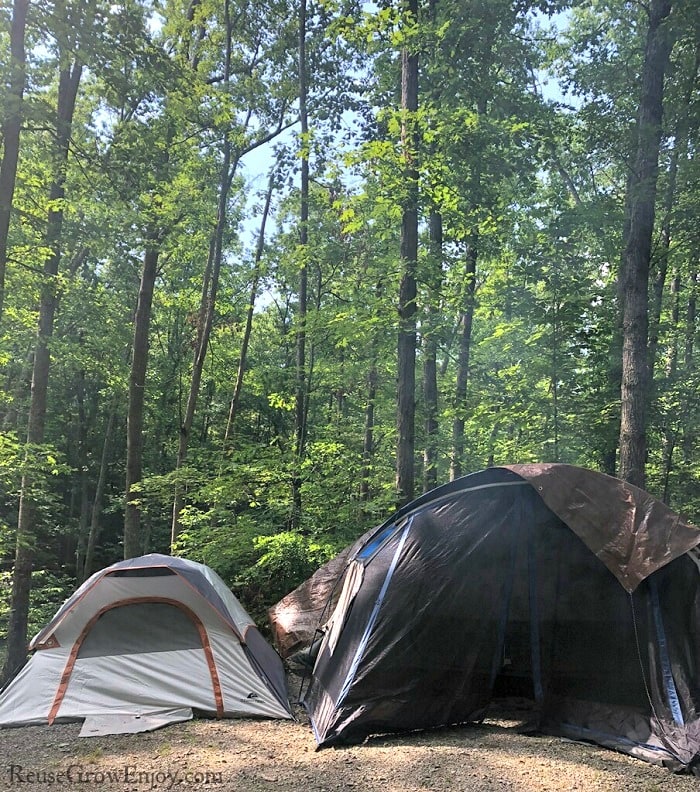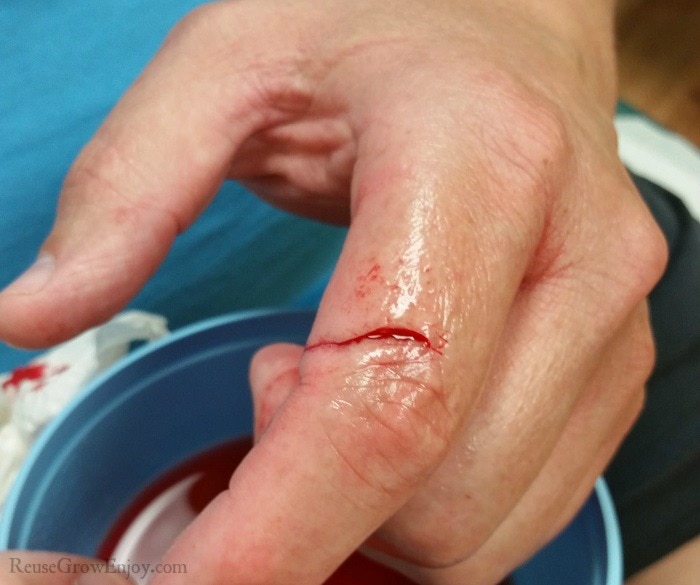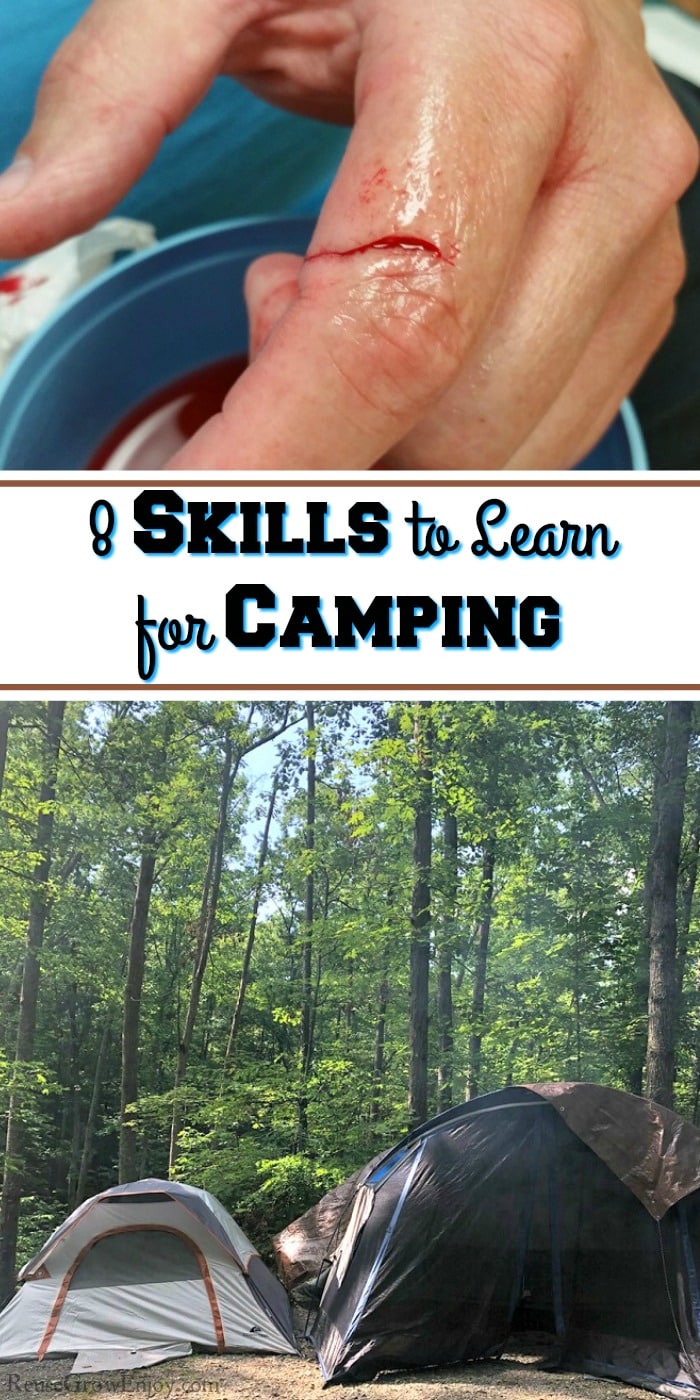Thinking of going camping, maybe for the first time? Be sure to check out these 8 skills to learn for camping before you go so you can make the most of your trip.
8 Skills to Learn for Camping
Camping, hiking, and other outdoor activities are always fun this time of year. If you want to make the most of your time outside, these are some useful skills to learn for camping that will help you. These are just a few outdoor skills everyone should learn.
After you learn these skills, you may also want to check out my page on Camping Hacks That Really Work!
Starting a Fire:
Learning to start a fire can help you cook, clean water, and stay warm on cool nights. You’ll need to know about what materials to use and a few basic safety guidelines. First, know your materials:
- Gather tinder. Tinder is any small and very flammable materials that are good for getting your fire started. Paper, wood shavings, or small pieces of cardboard all make excellent tinder. The materials should be very dry. You can also use commercial fire starters that are made for this purpose.
- Add kindling. Kindling is the next step up in size from tinder. Small twigs and pieces of wood are perfect.
- Use firewood. Depending on the size of your fire pit, you might use whole or split logs.
If your site already has a fire pit or a fire ring, you should be all set to build your fire there. If you need to create one, the first step is to remove all vegetation from an area with an 8 to 10 foot radius. There should only be dirt – no grass, leaves, or other debris.
Next, dig a hole in the center of the area several inches deep. You can surround the perimeter of the hole with rocks or with the loose dirt if you wish.
Now, build your fire:
- Add tinder to the fire pit.
- Arrange kindling in a “teepee” fashion over the tinder.
- Arrange firewood in the same way over the kindling.
- Ignite the tinder using a long match or lighter, or ignite a twig and use that flame to ignite the tinder if you only have regular matches.
This arrangement allows the fire to build up quickly. Now, you’ll just need to add firewood occasionally as the fire dies down. If you need to see step by step check out my post on How To Build a Campfire.
To put out the fire quickly, smother it with dirt. Be sure to put the fire out and allow the fire pit to cool completely before leaving the area. Never leave a fire unattended.
First Aid Skills:
You never know what might happen while you’re out adventuring. Knowing some basic first aid skills is a crucial safety step! Learn how to care for many different types of wounds and injuries such as:
- Cuts
- Burns
- Bites
- Rashes
- Sprains
- Broken bones
Even just knowing how to care for someone on the way to emergency services can make a big difference in the outcome. Taking a first aid course is a great way to learn how to deal with these injuries.
Plant Identification:
You don’t need to become a botanist or anything, but there are many plants you should know about. It’s also good to learn the basics of plant identification.
When you’re identifying a plant, you want to look at all the different parts of the plant and know some of the vocabulary used in the plant world.
First, learn to identify plants that are local to you. Get to know the plants that are poisonous as well as those that are edible or that can be used for medicinal purposes.
There are some great apps that can help you learn what the plants are. Check out these 7 Apps to Help You Identify Plants.
Sourcing Clean Water:
Running out of water is dangerous, so knowing how to find and clean water to drink is essential. The average person needs at least 2 quarts of water every day in order to survive.
In general, it’s best to get water from a fast-moving source rather than a stagnant source. The water will be cleaner and fresher.
Animals know where to find clean water, so look for animal tracks along banks and animals drinking from water sources.
Those are great signs that the water source is good. Watching bird flight paths in the morning and evening is another indication of where to look for water.
Consider gravity: water flows downhill so look at valleys and other low-lying areas.
Navigation:
You don’t want to get lost, so learn the basics of navigation. Reading a compass is one aspect, but there are many ways to use nature itself to navigate.
Many of us have heard that “moss only grows on the north side of trees.” This is usually true (in the Northern Hemisphere, anyway – in the Southern Hemisphere, moss usually grows on the south side of trees!), but don’t rely on this signal alone, since other factors can create the shady environment where moss likes to grow.
There are other ways to use nature to navigate that are much more reliable. For example, at night, the stars can guide you. During the day, the position of the sun is helpful.
Swimming:
If you don’t know how to swim, you might find yourself traveling further than you hoped to move around water, or worse: stranded.
It’s just another skill to add to your arsenal that will help keep you safe and happy outdoors. For kids, there’s no better time to learn how to swim.
Local pools often offer seasonal swimming lessons so be sure to call around.
Expert Knot Tying:
Knot tying might seem random, but there are so many situations where it can help you. Building a shelter, fishing, and hunting, carrying a large load are all situations where the right knot can make your task much easier.
These 10 rope knots are useful in a variety of scenarios.
Weather Signals:
We have all become so used to looking up the weather forecast online, so some weather signals have been forgotten. It’s good to know different weather patterns in order to stay safe. You don’t want to be out on a lake when a storm hits, for example. There are a few types of signals to learn about and look for:
- Types of clouds
- Animal behavior
- Other nature signs
Learning all these skills might seem overwhelming, but just do your best. You can learn these skills with online research, practice, or even by taking a local survival class if there’s one available to you. Get your family on board, too!






Leave a Reply